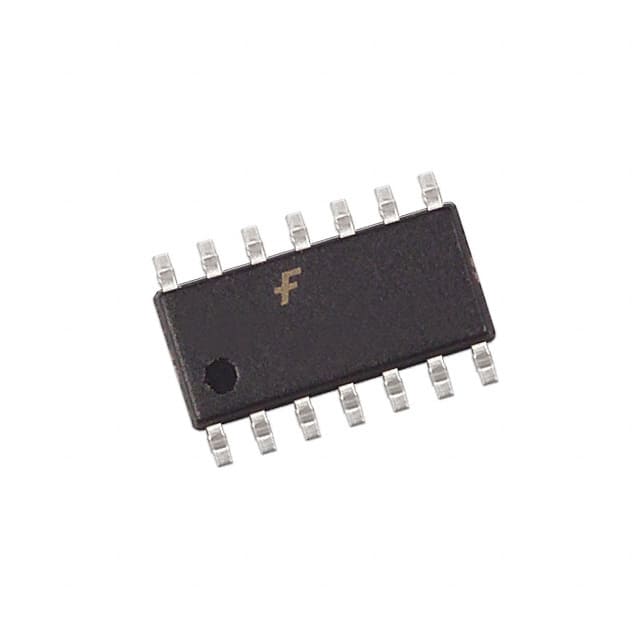MM74HCT74SJ
Product Overview
- Category: Integrated Circuit (IC)
- Use: Flip-Flop
- Characteristics: High-Speed, CMOS Technology
- Package: SOIC (Small Outline Integrated Circuit)
- Essence: Dual D-Type Positive Edge-Triggered Flip-Flop
- Packaging/Quantity: Tape and Reel, 2500 units per reel
Specifications
The MM74HCT74SJ is a dual D-type positive edge-triggered flip-flop integrated circuit. It operates on high-speed CMOS technology, making it suitable for various digital applications. The IC comes in a Small Outline Integrated Circuit (SOIC) package, which provides ease of handling and compatibility with standard PCB designs. Each reel of the MM74HCT74SJ contains 2500 units, packaged in tape and reel format.
Detailed Pin Configuration
The MM74HCT74SJ has a total of 14 pins, each serving a specific function. The pin configuration is as follows:
- CLR (Clear Input)
- D (Data Input)
- CLK (Clock Input)
- GND (Ground)
- Q (Output)
- Q̅ (Complementary Output)
- PRE (Preset Input)
- VCC (Power Supply)
9-14. Reserved for future use
Functional Features
The MM74HCT74SJ offers several functional features that enhance its usability in digital circuits:
- Positive Edge-Triggered: The flip-flop is triggered by a rising edge of the clock signal, ensuring precise timing control.
- Dual D-Type: The IC includes two independent D-type flip-flops, allowing for simultaneous operation or separate functionality.
- CMOS Technology: The use of Complementary Metal-Oxide-Semiconductor (CMOS) technology ensures low power consumption and high noise immunity.
- Wide Operating Voltage Range: The IC can operate within a wide voltage range, typically between 2V and 6V, making it compatible with various digital systems.
Advantages and Disadvantages
Advantages of the MM74HCT74SJ include:
- High-speed operation
- Low power consumption
- Wide operating voltage range
- Compact SOIC package for easy integration
Disadvantages of the MM74HCT74SJ include:
- Limited number of flip-flops (dual)
- Not suitable for applications requiring more than two flip-flops
Working Principles
The MM74HCT74SJ operates based on the positive edge-triggered D-type flip-flop principle. When the clock signal transitions from low to high (rising edge), the data input (D) is captured and stored in the flip-flop. The stored value appears at the output (Q) and its complement (Q̅). The clear input (CLR) and preset input (PRE) allow for additional control over the flip-flop's state.
Detailed Application Field Plans
The MM74HCT74SJ finds applications in various digital systems, including but not limited to:
- Sequential Logic Circuits: Used as building blocks for counters, shift registers, and other sequential logic circuits.
- Data Storage: Employed in memory units and registers to store and retrieve data.
- Clock Synchronization: Facilitates synchronization of multiple digital components using the clock input.
- Digital Communication: Enables data transmission and reception in digital communication systems.
Detailed and Complete Alternative Models
Alternative models that serve similar functions to the MM74HCT74SJ include:
- SN74HC74: Dual D-Type Flip-Flop, available in different packages such as DIP and TSSOP.
- CD4013B: Dual D-Type Flip-Flop, compatible with a wide range of supply voltages.
- MC74HC74A: Dual D-Type Flip-Flop, offers enhanced noise immunity and latch-up performance.
These alternative models provide similar functionality to the MM74HCT74SJ and can be considered as replacements based on specific requirements.
Word count: 456 words
Lista 10 Vanliga frågor och svar relaterade till tillämpningen av MM74HCT74SJ i tekniska lösningar
Sure! Here are 10 common questions and answers related to the application of MM74HCT74SJ:
Question: What is MM74HCT74SJ?
Answer: MM74HCT74SJ is a dual D-type flip-flop integrated circuit (IC) that can be used in various digital logic applications.Question: What is the operating voltage range for MM74HCT74SJ?
Answer: The operating voltage range for MM74HCT74SJ is typically between 4.5V and 5.5V.Question: What is the maximum clock frequency supported by MM74HCT74SJ?
Answer: MM74HCT74SJ can support clock frequencies up to 25 MHz.Question: Can MM74HCT74SJ be used as a counter?
Answer: Yes, MM74HCT74SJ can be used as a basic counter by connecting the output of one flip-flop to the input of the next flip-flop.Question: How many flip-flops are there in MM74HCT74SJ?
Answer: MM74HCT74SJ contains two independent D-type flip-flops.Question: What is the typical propagation delay of MM74HCT74SJ?
Answer: The typical propagation delay of MM74HCT74SJ is around 15 ns.Question: Can MM74HCT74SJ be used in battery-powered applications?
Answer: Yes, MM74HCT74SJ can be used in battery-powered applications as it operates within a low voltage range.Question: Is MM74HCT74SJ compatible with TTL logic levels?
Answer: Yes, MM74HCT74SJ is compatible with both TTL and CMOS logic levels.Question: Can MM74HCT74SJ be used in high-speed applications?
Answer: Yes, MM74HCT74SJ can be used in high-speed applications due to its fast propagation delay and clock frequency support.Question: What are some common applications of MM74HCT74SJ?
Answer: MM74HCT74SJ is commonly used in digital systems, such as counters, registers, data storage, and synchronization circuits.
Please note that the answers provided here are general and may vary depending on specific use cases and requirements.


